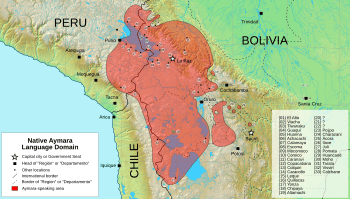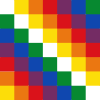Aymara kingdoms facts for kids
Quick facts for kids
Aymara kingdoms
|
|||||||||
|---|---|---|---|---|---|---|---|---|---|
| c. 1150–1477 | |||||||||
|
Banner
|
|||||||||

Aymara language domain
|
|||||||||
| Capital | Hatunqulla (Collas), Cutimbo (Lupacas), Caquiaviri (Pacajes) |
||||||||
| Common languages | Aymara, Quechua |
||||||||
| Other languages | Puquina, Uru |
||||||||
| Government | Confederation of Diarchies | ||||||||
| Historical era | Late Intermediate | ||||||||
|
• Established
|
c. 1150 | ||||||||
|
• Disestablished
|
1477 | ||||||||
|
|||||||||
| Today part of | Bolivia | ||||||||
The Aymara kingdoms were a group of strong native groups that lived in the Andes Mountains in South America. They are also called Aymara lordships or lake kingdoms. These groups grew powerful after the Tiwanaku Empire fell. They lived in a region called the Qullaw, which is near Lake Titicaca.
These kingdoms existed from about 1150 to 1477. They ended when the powerful Inca Empire conquered them. Today, about two million Aymara people live in countries like Bolivia, Peru, Chile, and Argentina. They speak the Aymara and Puquina languages.
Contents
Aymara Kingdoms: Ancient Rulers of the Andes
Where Did the Aymara Kingdoms Come From?
Before Europeans arrived, these groups did not call themselves "Aymara." Each group had its own name. European explorers were the first to use the name "Aymara" for them. But even then, they noticed differences among the Aymara-speaking peoples.
The Aymara people originally came from northern Argentina. Some Aymara descendants also lived near Lima when the Wari Empire was strong. A large movement of Aymara people helped break apart the Wari Empire's control. After the Wari Empire disappeared, many independent Aymara-speaking kingdoms appeared. Some Aymara groups moved to the central coast, taking advantage of the Wari's weakness.
Who Were the Aymara Kingdoms?
There were 12 main Aymara Kingdoms:
- Canchis (in Cusco)
- Canas (in Cusco)
- Collas (in Puno)
- Lupacas (in Puno)
- Pacajes (in La Paz)
- Carangas (in Oruro)
- Soras (in Oruro)
- Charcas (in Chuquisaca)
- Quillacas (in Potosí)
- Cara-caras (in Potosí)
- Chuis (in Sucre)
- Chichas (in Potosí)
There were also other important Aymara lordships:
How They Governed Their Lands
These kingdoms were divided into two main areas. Urcosuyu was on the western side of Lake Titicaca. Its name means "male" or "fire." Umasuyu was on the eastern side. Its name means "female" or "water."
These kingdoms controlled many lands, even in lower areas like valleys near the Pacific Ocean and the Amazon basin. They had lands that were not connected, like islands in different valleys. They often shared these valleys with other groups. This way of controlling land, with scattered territories, is called "vertical archipelagos." It allowed them to access different resources from various climates. Even after the Inca Empire took over, the Aymara kept their lands in the highlands and their colonies in the valleys. This system was respected until the Spanish conquest began. Then, their lands and political power started to break apart.
In all these societies, two leaders ruled together. This is called a "duality" government. Most of these kingdoms buried their leaders in special tower-shaped tombs called "chullpas." Each kingdom had its own unique design for these towers.
The Inca Empire Takes Over
The Aymara kingdoms often fought among themselves. The leaders, called kurakas, of the Lupaca Kingdom (from Chucuito) and the Colla Kingdom (from Hatunqulla) were big rivals. The Incas knew about these fights. The Inca ruler Viracocha Inca tried to use these rivalries to his advantage. He promised help to both sides but secretly agreed with the Lupacas.
However, Cari, the Colla leader, found out about this plan. He attacked the Lupacas near Paucarcolla before the Inca army could arrive. The Collas won this battle, becoming the strongest kingdom in the whole Qullaw region. They even took over land along the Pacific coast.
Later, another Inca ruler, Pachacuti, defeated the Collas. The Colla leader at that time was Chuqui Capac. He was captured by the Incas after a long battle near Hatunqulla. When the Incas conquered the Collas, their land stretched from the Pacific coast, across the Qullaw plateau, to the Mojeños mountains in the east.
After Chuqui Capac was captured, all the Colla people came under Inca rule. Some were conquered by force, while others joined peacefully. Towns that were destroyed were resettled by people called mitmakunas, who were moved by the Incas. Other Aymara kingdoms, like the Lupacas and Pacajes, also accepted the rule of Cusco, the Inca capital. After the Inca Empire expanded into the Aymara lands, the Incas called all Aymara kingdoms "Collas," without making a difference between them. Their territory then became part of a large Inca region called Collasuyo.
See also
 In Spanish: Reinos aimaras para niños
In Spanish: Reinos aimaras para niños


